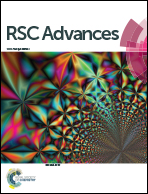Light trapping in hematite-coated transparent particles for solar fuel generation†
Abstract
Hematite (α-Fe2O3), due to its abundance and low-cost, is an attractive compound for photoelectrochemical splitting of water to produce hydrogen. However, one major obstacle preventing hematite from achieving the target efficiencies comprises its significantly smaller minority carrier transport distance relative to its optical absorption depth in the visible part of the optical spectrum. Here, we combine host–guest and Mie resonance concepts to achieve significant optical absorption in extremely thin layers of hematite. We propose and theoretically evaluate transparent particles coated with an extremely thin hematite shell as building blocks for hematite photoanodes. By full-field optical simulations we found out that maximal optical absorption is achieved when the particle supports two to three Mie resonance modes above the hematite optical absorption edge. Optical absorption efficiencies integrated over the air mass 1.5 global (AM1.5G) irradiance spectrum, 〈ηabs〉AM1.5, reach more than 2 mA cm−2 within a 10 nm thick hematite shell of a particle with optimal dimensions and 〈ηabs〉AM1.5 comes close to 5 mA cm−2 in a 25 nm thick hematite shell. Furthermore, we evaluate the performance when the particles are part of an array or stacked atop each other. The concept introduced here could be useful for improving optical absorption in semiconductors with extremely short carrier transport distances.


 Please wait while we load your content...
Please wait while we load your content...